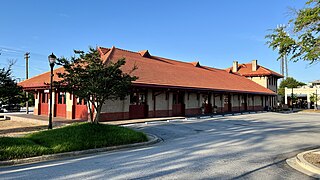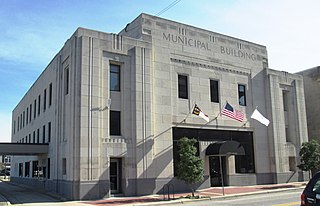
Greer is a city in the Greenville and Spartanburg counties in the U.S. state of South Carolina. As of the 2020 census, the population was 35,308, making it the 14th-most populous city in South Carolina. Greer is included in the Greenville-Anderson-Greer, SC Metropolitan Statistical Area, which is part of the Greenville-Spartanburg-Anderson, SC Combined Statistical Area in Upstate South Carolina.

The Reliance Building is a skyscraper located at 1 W. Washington Street in the Loop community area of Chicago, Illinois. The first floor and basement were designed by John Root of the Burnham and Root architectural firm in 1890, with the rest of the building completed by Charles B. Atwood in 1895. It is the first skyscraper to have large plate glass windows make up the majority of its surface area, foreshadowing a design feature that would become dominant in the 20th century.

The William Aiken House and Associated Railroad Structures make up a National Historic Landmark District in Charleston, South Carolina, that contains structures of South Carolina Canal and Railroad Company and the home of the company's founder, William Aiken. These structures make up one of the largest collection of surviving pre-Civil War railroad depot facilities in the United States. The district was declared a National Historic Landmark in 1963.

Todd is an unincorporated community straddling the county lines of Watauga and Ashe counties in northwestern North Carolina, United States on the South Fork of the New River. It lies at an elevation of 2,992 feet. The population was 2,141 at the 2010 United States Census. The ZIP Code for Todd is 28684.
R. T. Greer and Company may refer to:

St. John's Episcopal Church is a historic Episcopal church located on SR 1329 in Williamsboro, Vance County, North Carolina. It was built in 1773, and is a rectangular, seven bay long, frame church on a brick foundation. It has a gable roof and is sheathed in weatherboard. The church was restored in the 1950s.

The Bright Leaf Historic District is a national historic district located at Durham, Durham County, North Carolina. It encompasses 22 contributing buildings and seven contributing structures in an industrial section of Durham. The majority of the buildings were built from the 1870s to the World War II period, and are massive two- to four-story structures, usually rectangular in form with flat or very shallow gable roofs and of fireproof construction with brick exteriors. Notable buildings include the B. L. Duke Warehouse, the Italianate style W. Duke Sons and Company Cigarette Factory (1884), Liggett and Myers Office Building, Chesterfield Building, Flowers Building (1916), Imperial Tobacco Company Factory (1916), White Warehouse (1926), and five Romanesque Revival style buildings built by The American Tobacco Company trust—Walker Warehouse (1897), Cobb Building (1898), O'Brien Building (1899), Hicks Warehouse (1903) and Toms Warehouse (1903).

The Greer Depot is a former railroad depot listed on the National Register of Historic Places and located in Greer, South Carolina. The combination passenger station and freight warehouse was designed by the Charlotte, North Carolina-based architect, Charles Christian Hook, and constructed in 1913 for the Piedmont and Northern Railway. The depot was designed as a combination passenger station and freight warehouse for the Piedmont & Northern Railway and later used by Seaboard Coast Line Railroad, before facing potential demolition in 1983. It is the last surviving of the original 5 two-story depots built for the railway.

R. T. Greer and Company is a historic commercial building located at Marion, Smyth County, Virginia. It was built in 1916. R. T. Greer and Company was the Appalachian region's largest dealer in medicinal herbs. They remained in business until 1968. It is occupied by the Herb House Trading Company, Inc.

The American Tobacco Historic District is a historic tobacco factory complex and national historic district located in Durham, Durham County, North Carolina. The district encompasses 14 contributing buildings and three contributing structures built by the American Tobacco Company and its predecessors and successors from 1874 to the 1950s. Located in the district is the separately listed Italianate style W. T. Blackwell and Company building. Other notable contributing resources are the Romanesque Revival style Hill Warehouse (1900), Washington Warehouse (1902–07), the Lucky Strike Building (1901–02), and Reed Warehouse; Noell Building ; Power Plant and Engine House (1929–39); and the Art Moderne style Fowler (1939) Strickland (1946) and Crowe (1953) buildings.

Greer Downtown Historic District is a national historic district located at Greer, Greenville County, South Carolina. The district encompasses 40 contributing buildings constructed from ca. 1900 to ca. 1940, with the majority constructed between 1910 and 1930 in the central business district of Greer. They are largely two-story brick commercial structures. Notable buildings include the First National Bank of Greer, Planters Savings Bank, R. L. Merchant Building, Bailey Building, Bailes-Collins Department Store, and Davenport Building.

West End Commercial Historic District is a national historic district located at Greenville, South Carolina. It encompasses 15 contributing buildings in Greenville's second "downtown." The commercial buildings primarily date from about 1880 to 1920, and include examples of Victorian commercial architecture. Notable buildings include the American Bank, Alliance and Mills & McBayer Cotton Warehouses, Indian River Fruit Store, Pete's Place, Bacot's West End Drug Store/Stringer's Drug, Furman Lunch, and Greer Thompson Building.

Thomasville Downtown Historic District is a national historic district located at Thomasville, Davidson County, North Carolina. The district encompasses 46 contributing buildings, 1 contributing site, 2 contributing structures, and 2 contributing objects in the central business district of Thomasville. It includes commercial and governmental buildings built between 1871 and 1938. Located in the district is the separately listed Thomasville Railroad Passenger Depot. Other notable contributing resources include The Big Chair (1950), the former City Hall (1938), the former Davidson County Office Building, the former United States Post Office (1926), (former) Davidson County Office Building (1957), the Dr. Orien R. Hodgin Dental Office, the North State Telephone Warehouse, First National Bank of Thomasville (1922), C. R. Thomas Block, and the Lambeth Furniture Company/Thomasville Chair Company.

Watts and Yuille Warehouses, also known as Brightleaf Square, are two historic tobacco storage warehouses located at Durham, Durham County, North Carolina. They were built in 1904, and are two identical buildings parallel to each other with a courtyard in between. They are two-story Romanesque style brick structures, seven bays wide and twenty bays long. Each unit of the warehouses is 75 feet by 118 feet, for a total of 35,400 square feet on each floor. They are an example of "slow burn" masonry and wood factory construction. They were among the 12 brick tobacco storage warehouses erected by The American Tobacco Company trust beginning in 1897. The buildings have been converted to retail and office use.

Union Storage and Warehouse Company Building is a historic warehouse building located at Charlotte, Mecklenburg County, North Carolina. It was built in 1927, and is a two-story, rectangular, reinforced concrete building on a raised concrete basement. The building has a red brick veneer, steel sash windows, and a parapet facade. The warehouse was purchased by the Ford Motor Company and converted to an auto repair establishment in 1942.

Greenville Tobacco Warehouse Historic District is a national historic district located at Greenville, Pitt County, North Carolina. The district encompasses seven contributing buildings and one contributing structures in an industrial section of Greenville. It includes buildings dated from about 1905 to 1947 and notable examples of Art Deco and Italianate style industrial architecture. Contributing resources are the American Tobacco Company Storage Warehouse #2. ; the Prichard-Hughes Warehouse ; the Dail-Ficklen Warehouse ; the Export Leaf Factory ; the E. B. Ficklen Factory ; the Gorman Warehouse (1927); the Star Warehouse (1930); and the System of CSX Railroad Tracks.

Farmville Historic District is a national historic district located at Farmville, Pitt County, North Carolina. The district encompasses 330 contributing buildings, 1 contributing site, and 2 contributing structures in the central business district and surrounding residential sections of Farmville. It includes buildings dated from about 1860 to 1942 and notable examples of Colonial Revival, Classical Revival, and Queen Anne style architecture. Notable buildings include the James W. May House, Fields-Rasberry House, Dr. David Morrill House, Warren Parker House, Nannie Smith House, First Christian Church (1910), Emmanuel Episcopal Church (1920), St. Elizabeth Catholic Church, Municipal Building (1928) possibly designed by Benton & Benton, Bank of Farmville (1921) designed by Benton & Benton, Pollard Auto Company Building, Paramount Theatre (1930s), J. Y. Monk Tobacco Warehouse, and East Carolina Railway Office and Freight Station.

Spray Industrial Historic District is a national historic district located at Eden, Rockingham County, North Carolina. It encompasses 70 contributing buildings, 9 contributing structures, and 1 contributing object in an industrial section of the town of Eden. It includes buildings associated with eight textile mill complexes, mill village housing, and seven commercial buildings. Notable contributing resources include the Smith River Dam and Spray Power canal, Morehead Cotton Mill complex, "Superintendent's" House, Imperial Bank and Trust Company (1912), Leaksville Cotton Mills complex, Spray Mercantile Building, Spray Cotton Mills complex, Lily Mill complex, Nantucket Mills complex designed by R. C. Biberstein, American Warehouse Company complex, Rhode Island Mill complex, Phillips-Chatham House, and Spray Woolen Mill complex.

The Wilson Central Business–Tobacco Warehouse District is a national historic district located at Wilson, Wilson County, North Carolina. It encompasses 152 contributing buildings, 20 contributing sites, and 2 contributing structures in the central business district of Wilson. The district includes notable examples of Late Victorian and Art Deco style architecture. Located in the district are the separately listed Branch Banking Building, Cherry Hotel, and Wilson County Courthouse. Other notable buildings include the Woodard-Watson Warehouse, Planter's Warehouse, Passenger Station and Freight Depot (1924), Jackson Chapel First Baptist Church (1913), St. John's African Methodist Episcopal Church (1915), Imperial Tobacco Company, Winstead-Hardy Building, Rountree Building (1870s), Planter's Bank Building (1920), United States Post Office and Courthouse (1927), Charles L. Coon High School (1922), First National Bank of Wilson Building (1927), Wilson Theatre (1922), Odd Fellows Lodge (1896), and the Works Projects Administration financed Wilson Municipal Building (1938).






















